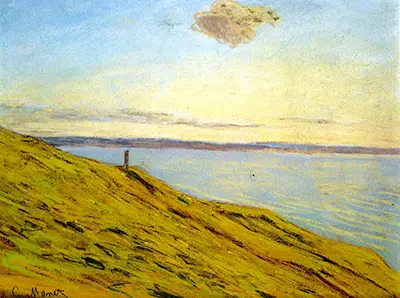As was typical of him, Monet created several depictions of the Sainte-Adresse estuary, and several of the others were done in oils rather than pastel colours.
Creating a series of works of art depicting the same natural phenomenon was a hallmark of Monet's style - by making series like these, he was able to show how different seasons and different lighting effects could make the same phenomenon look vastly different.
Created at some point between 1865 and 1870, Sainte-Adresse, View across the Estuary is a very bright looking piece. It shows us the sweeping curve of a light green hill and the shimmering bluebell coloured water of the estuary itself. The viewer is placed at an elevated point, able to survey the vast expanse of much of the landscape. This enables them to 'stand' where the artist was standing.
Like the majority of Impressionists in his circle, and like the French Barbizon school of art just before him, Monet liked to paint out in the open air, which lead to the development of an Impressionist style called 'en plein aire'. The freshness of the air can definitely be felt as the viewer gazes at Sainte-Adresse, View across the Estuary.
This art work is currently in a private collection, so it is not open to public view - the majority of Monet's works however are held in museums and galleries in his native France so that the public can access them whenever they please.
Sainte-Addresse is located in Normandy, and again this is not surprising because many of Monet's pastel drawings from the mid 19th century were done in Normandy. The estuary can still be visited today, though much of it is rocky and stony as opposed to the lush green hillside that Monet chose for his pastel piece Sainte-Adresse, View across the Estuary.
That Monet chose this view suggests that he wanted to create a more lush and springlike feel to his piece.
There is definitely a sense of stillness to Sainte-Adresse, View across the Estuary, and this tranquil art work also heavily features one of Monet's obsessions: light. One of the main interests of the Impressionists was in depicting the reflections of light on water, and capturing the way in which light appeared differently in the sky.
One of Monet's other pastel pieces, Nightfall, for example, manages to depict the very moment that night falls across the sky in a way that is still filled with light and colour. Monet often painted at daybreak and evening so that he could take advantage of different light effects - this could be compared to film makers' preference for shooting during the 'magic hour' of light.


